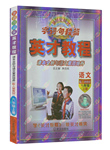题目内容
These doctors are busy day and night, a cure for AIDS.
- A.bringing on
- B.pulling on
- C.taking on
- D.working on
动词短语辨析。bring on引起, 使发展, 提出;穿上;pull on继续拉;穿上;take on雇佣,呈现,承担;work on从事于,进行;句意:那些医生日夜忙碌,进行对艾滋病的治疗。

 字词句段篇系列答案
字词句段篇系列答案Often we take for granted the many household items we use every day. It is difficult to imagine there was a time in the past when these inventions did not exist. Actually, several of the most common inventions have been with us for quite some time. Inventions like toothbrush, contact lenses(隐形眼镜), and credit cards came into use long ago.
The first toothbrush was introduced in China in the late 1400s but it was only 300 years later that this simple tool came into common use in Europe. By the nineteenth century, a variety of paste and powder cleaners were available throughout Europe as dental(牙齿的) care became more widespread. The first tube of toothpaste hit the market in Great Britain in 1891.
There is evidence to show that the first contact lenses were actually suggested by an astronomer, Sir John Herschel, in 1827. However, SirJohn Herschel was never able to create a working model of his idea. It was not until 1887 that a Swiss doctor from Zurich, Dr. Eugen Frick, came up with a workable process for producing precision (精密)lenses. Dr. Frick designed a new method for producing contact lenses,and the Zeiss factory in Germany began to produce contact lenses.
Credit cards have also been available for many years. They have been in use in the United States since the 1920s. At first, these cards were only used to buy gas in the quickly growing automobile service industry. Then, in the 1950s, Diners Club introduced the first general-purpose credit card. Today, credit cards such as Master Card, Visa, and American Express are commonly used by travelers around the world.
While it may be true that some of the greatest inventions and discoveries in history came about by chance, the majority of inventions that simplify our lives today came about through careful research and patient study. Of course, it still holds true that even with all the comforts of modern technology, inventors continue to search for ways of helping all of us get out of doing those necessary but tedious (乏味的) tasks which we still face. As the old saying goes, “Necessity is the mother of invention.”
1.From the second paragraph we can learn that _____.
A. toothbrushes came into common use in Europe in the 17th century
B. people could enjoy a variety of paste and powder cleaners in the 18th century
C. more and more people paid attention to dental care throughout Europe in the 19th century
D. the English could use different kinds of tubes of toothpaste in the early 19th century
2.All of the following made a contribution to the invention and use of contact lenses EXCEPT _______.
A. Diners Club B. Sir John Herschel
C. Dr Eugen Frick D. the Zeiss factory
3.Which of the following statements is TRUE according to the fourth paragraph?
A. Credit cards have a history of about two hundred years.
B. Three kinds of credit cards are being used in the USA.
C. The use of credit cards is closely related to the economic development.
D. American Express is only used by American travelers now.
4.The last paragraph mainly tells us that ______.
A. the greatest inventions came about by chance
B. inventions came about through careful research and patient study
C. inventors still continue to make inventions
D. necessity is the mother of invention